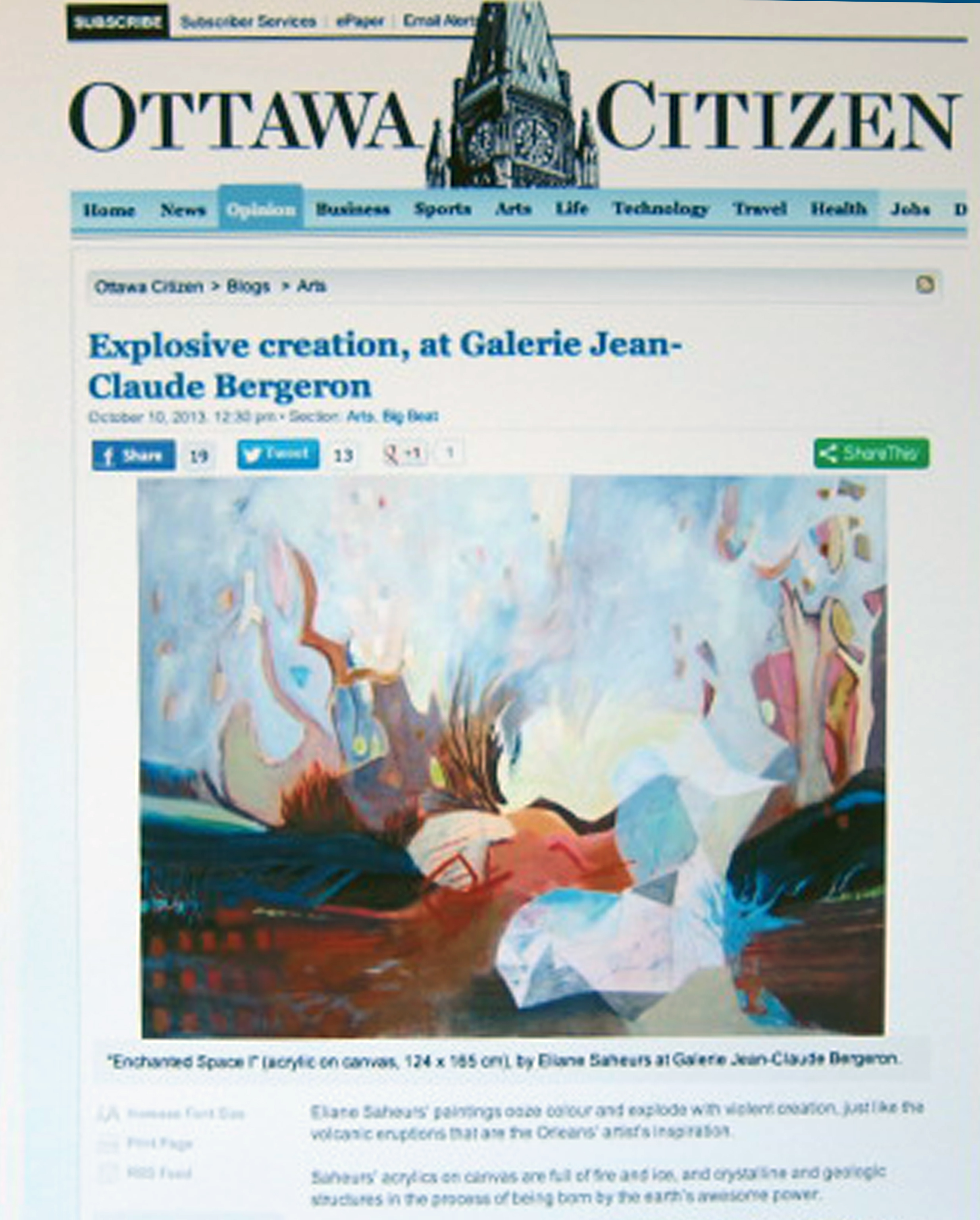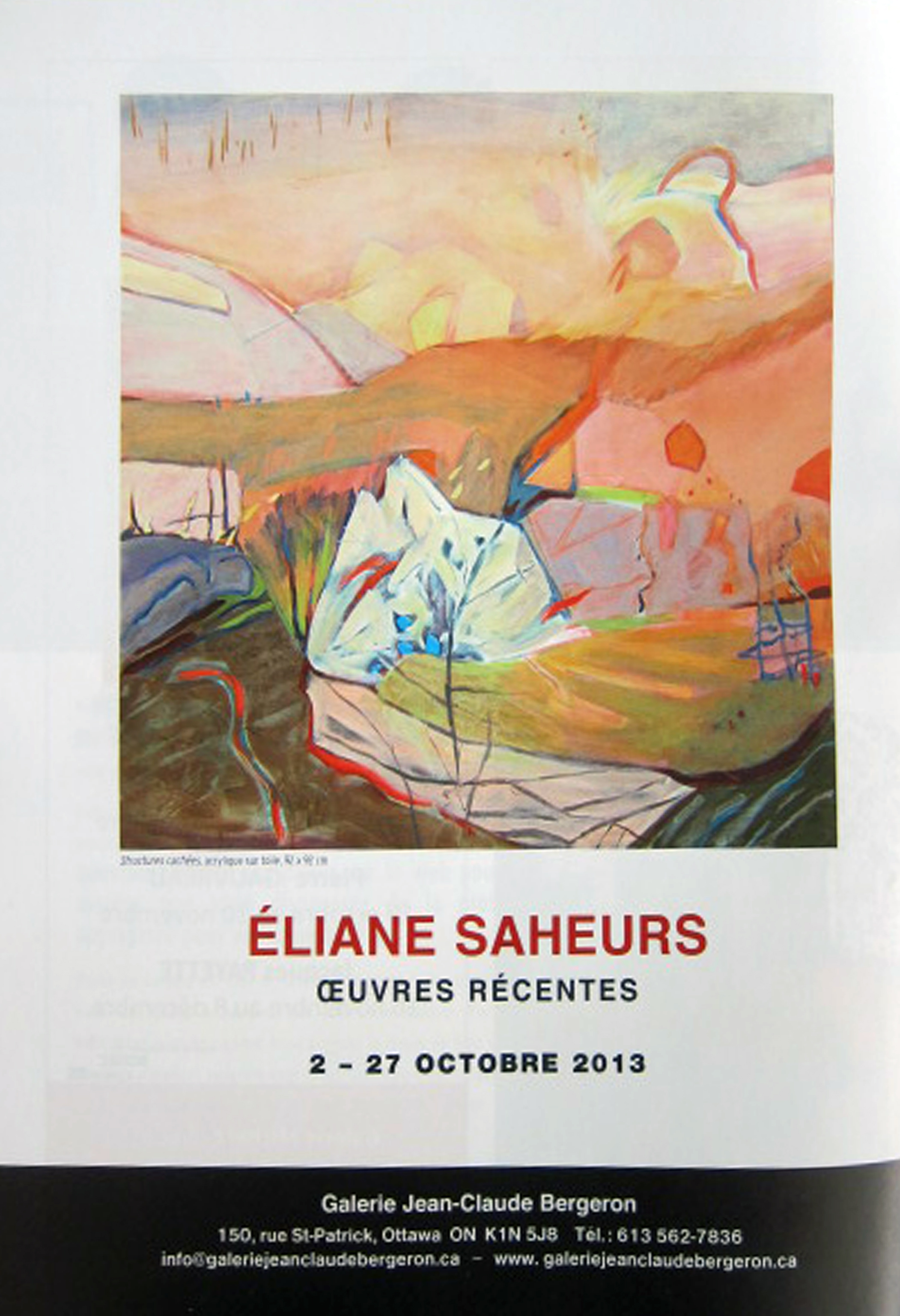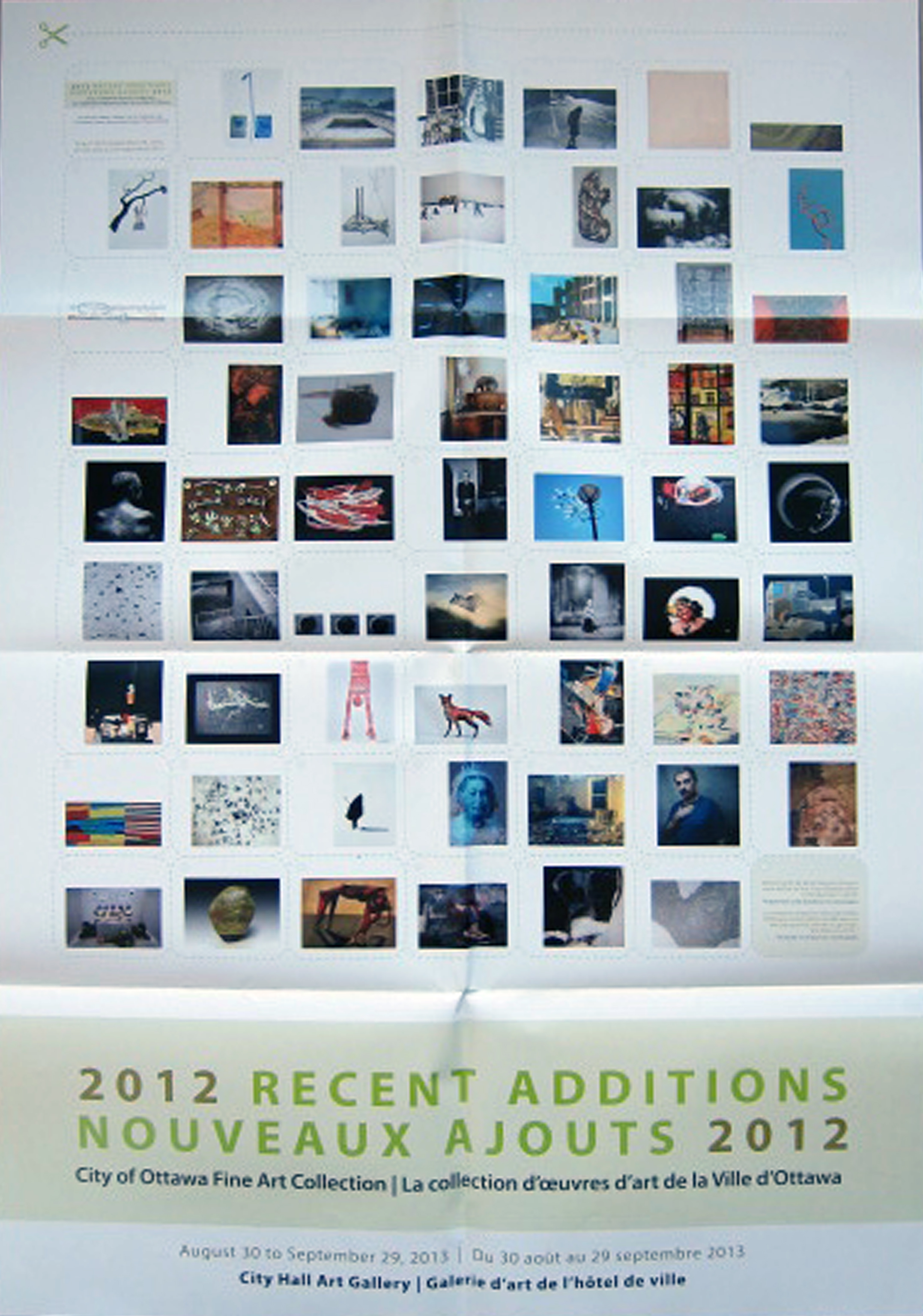^
Testimonials

Opening: Recent Aquisitions of City of Ottawa with Mayor Watson, Dec. 2015
Karsh Masson Gallery, Ottawa
ROCK, WATER, LIGHT: Paintings by Eliane Saheurs
Eliane Saheurs' paintings are noisy compositions. They are the noise of water crashing over granite, of precipices breaking into rockfall.
Footfall adjusts to shifts of terrain. Rhythms of walking focus attention on light playing across surface. Just as the parasympathetic nervous system feeds data to the brain, so, too, did the ancient trails of animals lead us up and over the mountains. These are the pathways Eliane Saheurs walks. We see her intimate knowledge of terrain—rock, water, light—in her art.
Mountain trails have taken Eliane Saheurs into the reveries of these compositions. As she walks, she looks, listens, documents. The artist knows the rocks well—both scientifically and experientially. Her understanding of terrain and structure is one scientifically informed, and as multi-layered as the rocks themselves. Not only does Saheurs understand the language of geology, her small studies entitled “Mineral Structures” ( 2013) make this language clear to others, too.
There are no quiet lakes in Eliane Saheurs' compositions. The artist very often uses aerial perspectives to hurl us up right up against absurd contradictions-- water sculpting rock. “From Dark to Light VIII” (2012), for example, splashes white light against grey—the prismatic colour of water against grey rock. Cyan mysteriously appears--for a moment—in the foreground. “Lavertezzo” (2012) bursts out of centre into a cascade of red, yellow, blue splashing everywhere. We can see the tumult of cascading waters in the mountains.
Lavertezzo, an old town in Switzerland, is famed for its 17th-century double-arched stone bridge crossing the river far below. In Saheurs' painting, we look over that bridge into fiery hell.
Eliane Saheurs is Swiss-born. She knows how the mountains pushed through the earth's crust, how glaciers scissored rock, how rocks are severed by waterfalls. Walking through these forests, we hear the sound of water rippling. The wind is shifting cloud and light over mountain crests. Then, there is a break in the path. There, we find a sense of wonder, enchantment, too. In 2012-2014, Eliane Saheurs completed a series of seven paintings serially entitled “Enchanted Space.” Rock, Water, Light includes all but one from the series.
Experiences of enchantment are particular to time and place. “Enchanted Space VII” (2014), for example, might be the site of a small animal's lodge, or another hidden place; “Enchanted Space III” (2013), on the other hand, is surely the dance of light in late August. Are “Enchanted Space I” (2012) and “Enchanted Space II” (2013) the places behind waterfalls where mysteries are kept secret? If so, then “Enchanted Space VI” (2014) takes us even further back into the cave behind the waterfall. If we are very brave, the truths of ”Enchanted Space V” (2014) might be revealed.
The terrain of ancient mountains is one of fracturing and entanglements across time. Human beings have left their records behind here, too, as we see in “Hidden Structures XIV” (2010). The scene has the look of beach debris at the end of a long weekend. Lost towels, jelly fish, and bits of bathing suits might be underneath the sand, if they have not already been lost in the tide.
No matter. In the end, rock, water, light remain. We begin again.
Maureen Korp, PhD


Vie des Arts No. 232 automne 2013

2011: Ten paintings by Eliane Saheurs
Maureen Korp, Ph.D.
In more than a few respects, artist Eliane Saheurs’ recent paintings are like a traveller’s treks into high mountains. Sometimes we can see far, clear across the valleys, even so far as the next mountain ridge. More often, as we pick our way along the path, we watch where we are going.
The path is slippery. We make our way with hand and foot. Little rocks go tumbling. Then, clearing the forest, straight ahead, at last the promised resting point comes into sight. We can sit down, look out, take in the view, have a snack, and talk about what we are doing, what we have seen, and where we are going.
Eliane Saheurs is Swiss-born. Rocks, mountains, and the scarlet lights of sun on rock are colours and shapes she knows well. The artist has photographed and painted these forms from a complex point-of-view–one as much scientific as mystic–for more than thirty years.
Use of aerial perspective
In her paintings, Eliane Saheurs often uses an aerial perspective to pull the viewer into the scene. In Susten, for example, the composition’s straight dark lines are broken in a frothing, icy white vortex. Looking straight ahead and above the tumult, the viewer confronts a worse possibility. An abyss--bleak, dark, and wintry.
Interestingly, Susten’s shapes, colours, and compositional tensions are allied to those the artist also uses in Hidden Structures XXI. If the two paintings are seen side-by-side, the viewer realizes Hidden Structures XXI depicts the critical moment before all hell breaks loose, and Susten the aftermath.
Hidden Structures XV, on the other hand, suggests the detritus at end-of-day, a twilight of benign possibilities. Were it possible to imagine beach toys, candy wrappers, mussel shells, lost towels, jellyfish, fishing nets, and bathing suit bits blowing about in the ocean’s wind, then a hundred years of Coney Island might look like Eliane Saheurs’ Hidden Structures XV.
Miró’s influence
A few intriguing comparisons might be made between the work of Spanish artist Joan Miró (1893-1983) and Eliane Saheurs. For starters, both artists play with time in similar ways in their compositions.
In the early 1920s, Miró undertook a series of landscapes depicting time seen, and time unseen. Although the artist retained the horizon line of present day in his landscapes, in the shadows, we find overlooked narratives from yesterday and from today–both outside in and inside out. For example, in Miró’s Farmhouse, 1921-2, the house is being built, and demolished right before us; and, in Ploughed Earth, Montroig (1923-4), Miró’s landscape includes the yawping postures of bull, horse, farmer’s dog and duck, plus a chicken or two. As well, an ear to hear and an eye to see may be found among the painting’s many wonders.
In her paintings, Eliane Saheurs also asks the viewer to reach back into memory–not just to lived, present-day memories of the 21st century, but further–as far back as cellular memory of bone and Pleistocene rock.
In the lower left of Saheurs’ painting Hidden Structures XXIII, for example, we might see, momentarily, the blues and greens of a deep glacial lake. Straight ahead, however, we lose the horizon in an infinite expanse of white. On the right, a sudden eruption of yellows, greens, bits of red and purple. What is all this wild activity ? Does it make any noise? The viewer can only imagine.
Use of diagonal
Saheurs sometimes employs a diagonal motion in her compositions. Miró did so, too, but rarely. Miró preferred a contemplative grid. The two thin diagonal lines of his Motherhood, 1924, for example, are counterposed lines of stasis. Saheurs, however, employs the diagonal as an active, kinetic force.
In three of her recent paintings--Albite, Bellinzona, and Ilimenau–we see blues and purples pushing pinks and oranges across the composition. In two other recent paintings, Hidden Structures XVI and Hidden Structures XXIV, the artist tumbles airborne objects--some falling, some flying--across the picture plane and along a diagonal.
Becoming aware of any diagonal movement somewhere off the edge of peripheral vision always turns the viewer’s head around. The wind is ruffling the trees.
Here is where the mountain’s path is bending.
Hidden Structures I is remarkable work. Blue and orange dance above the plane. An orchestra of strings and bows in vibrant yellows and reds plays out along the bottom edge. The painting’s composition keeps the viewer in the centre of the action while unfolding layer upon layer, possibility upon possibility, in a light calligraphic hand. A synthesis of sound and colour appears within reach. Here is the multivalent painting upon which the artist’s next series of work can be built.
In conclusion...
The story of painting is more than that of a particular time, place, or artist. Our ancestors knew, when they used ochre to paint story upon rock; the colour itself–often mouth-sprayed upon rock--was infused with the breath of the artist. These colours are the very same favoured by artist Eliane Saheurs’ in her work today.
When we attend to an artist’s work, following line, colour, and shape, we slow down our breathing, focus distracted attention, and enter into, as Eliane Saheurs writes, a “...hidden world of emerging and submerging structures and shapes.” What could be better? We collapse time. For a moment, we have suspended mortality.
copyright 2012 by Maureen Korp, Ottawa
__________________________________________________________________________
"Eliane Saheurs - Consummate Artist, whose work is inspired by earth's evolution and forms has a new exhibition at Galerie d'art Jean-Claude Bergeron.... allowed her to work much larger and with richer layers of colours and textures...."
Susan Hallett, The Epoch Time, March 12, 2010, B2 Arts and Culture
__________________________________________________________________________
"....many of her paintings appear to be completely abstract at first glance, a closer inspection reveals that an exploration of the geological goings-on of planet Earth is in the works - striations of rock are layered upon one another, revealing billions of years of activity. This is painting that makes you think of how small and insignificant humans really are...."
Melanie Scott, Interiors, premier issue 2004
__________________________________________________________________________
"...ses paysages rocailleux ... les textures de froissement deviennent comme une peau sur la froideur de la roche. Le mariage des techniques de gravure fait bon ménage et ajoute une richesse tactile...."
Dominique Laurent, Le Droit, 1998
__________________________________________________________________________
"...although the paintings have a highly structured formal balance, the viewer is aware of the body strength and gestures it takes to get the sweep of paint, the upward force in Eruption or the aqueous drift of matter in Sedimentation...
The one constant in her work is her use of collage, her layering. This buildup, the sense that everything carries its own imbedded history....
... her forte is the big statement. In the painting Sedimentation, Saheurs evokes a calm sense of power, of tactility, of an intimation of the physical laws of the universe that govern the evolution and devolution of matter through a parallel sense of process."
Nancy Baele, The Citizen, 1994